#chinese buddhist
Explore tagged Tumblr posts
Text

I have neglected my bodhisattva for a very long time. She understands, of course, but I feel like I deserve a smack in the face by one of her lotus leaves. Maybe I'll do some meditation with my mala and then I'll calm down.
#guanyin#buddhism#bodhisattva#chinese buddhist#buddhist witch#religions#spirituality#religious ramblings#chinese witch
16 notes
·
View notes
Text

"It would be my pleasure to give you a proper tour and introduce you to everyone."
Here is my full illustration for @svsssbigbang for the fanfiction Night at Cang Qiong Museum by @adventure-waffles! An incredible Night at the Museum x Scum Villain AU! Don't hesitate to also check out the other two artists incredible pieces for this fanfiction: dustmeadowx and qiye!
And since I know that tumblr tends to destroy the quality of my illustrations, here are some close-ups under the cut:



#svsss#scum villain's self saving system#ren zha fanpai zijiu xitong#bingqiu#liu qingge#luo binghe#shen yuan#bingyuan#yue qingyuan#e-ming#making a cameo because idk I thought it'd fit#night at the museum au#svsss au#fanfiction fanart#fanfic fanart#svsssbigbang#myart#“I'll make paintings in the backgroud it'll be easier!�� little did I know... I would have to learn chinese inking techniques for this#I've visited a lot of museums while working on this illustration and it helped greatly#in my top museums? Kanagawa's history museum and the Cluny Museum in Paris first got great exhibits second great lighting#seen lots of buddhist art too in japan so that inspired me to draw yqy as a statue#I tried to imitate the cloth folds and the way they sculpted the hair on those buddhas while also keep it different enough#anyway look at sy why is he so short he's so cute I could carry him in my pocket#he looks like a twelve year old boy that got lost in the museum aaaaw (that's a grown man)#go read the fic now what are you still in the tags for go go
2K notes
·
View notes
Text




Luohan Temple 罗汉寺 is a Buddhist temple located in Chongqing city, China. It is the site of the Buddhist Association of Chongqing.
This temple was built by a prominent monk Zuyue 祖月 in the Zhiping period (1064–1067) of the Song Dynasty (960–1276). At that time it was called "Zhiping Temple".
The temple was renovated and expanded in the following Ming and Qing dynasties, and also during the ROC and PRC eras.




#china#🇨🇳#chinese heritage#chinese culture#chinese architecture#Sichuan#Chongqing#Sichuan province#chinese#people’s republic of china#prc#chinese history#sino#Chinese temples#Chinese Buddhism#Chinese Buddhist temple#temples#Chinese Buddhist architecture#Chongqing architecture#Sichuan architecture#Buddhism#song dynasty#architecture#han chinese#chinese houses
636 notes
·
View notes
Text

Irene Chou (Zhou Lüyun, 1924-2011) — Heartbeat [ink and colour on xuan paper, hanging scroll, 1980]
892 notes
·
View notes
Text
A Catalog of the Monkey King’s Magic Powers and Skills
I am happy to announce that I've finished my 177-page catalog of Sun Wukong's powers from all 100 chapters of Journey to the West. Fans of Lego Monkie Kid and Black Myth: Wukong, fanfiction writers, and artists will certainly find it useful.

#Sun Wukong#Monkey King#magic#Chinese magic#Taoist magic#Buddhist magic#magic eyes#magic hairs#Journey to the West#JTTW#Lego Monkie Kid#LMK#Black Myth Wukong#fanfiction#Chinese religion#Chinese mythology#cloud somersault#Fiery eyes
592 notes
·
View notes
Text

ive been thinking about the red string superstition recently and also sol bufo always and it makes me sick how uncannily caldwell tanner has made sol to perfectly target me personally


(+ cropped versions !)
#naddpod#ba2mia#ba2umia#solum bufo#swag daniels#calliope petrichor#calder kilde#alexandrite#posts by me dot com#okay..... SECRET TAGS RAMBLE!#so basically this superstition is like ... i think a chinese/buddhist/taoist superstition?#ive taken some creative liberties with it... but its mostly accurate to how its been told to me?#but of course theres lots of variations! some more abt bad luck; some say to tie it on the doorknob#etc etc ... lots a variations#i was also rlly interested in the .... weird illogic? of the thing?#like the red attracts and repels spirits at the same time#so thats something i was thinking about with too. red is assocuated with both swag and alexandrite. which to me was kinda reflecting like#i think what murph said . swags place in the wild is in a way. an extension of what he learned from the network#mothership s inextractivle from sol and swags lives. they will always be held doen by it. thats the spirit that will follow them forever#that they choose to hold on too! as much pain as it brought ... some of the experience was worth it#and anyway. theres somethingwrong w me that the minute someone brought up this superstition my brain went#'ohhh just like sol!' < needs to touch grass moment#but i CANT BELIEVE. CALDWELL DID THE RED STRING. AND ITS LITERALLY A MOURNING RITUAL#caldwell keeps accodentally makig that frog ASIAN. to MEEEE!!!!!!#but. anyway. idk. ive always hced sol kept the piece of yarn and it makes me kinda .... what if y let the malicious spirits follow you.#and haunt you. what if its the closest you can get to keeping the person still around#and sol and swag obviously have so much about homes .... so!#(ok. weve reached the pt where maybe nobodys reading? so confession is this is sort of a well. ive just been doodling this comic everyday#after a wake. and it was sort of inspired after realising i was even a bit sad about it maybe. so. idk its about sol but also?#i guess the projection doesnt end at him being asian. hehe. is what i mean. LOL. okay secret tags over . buried lore. dont look here folks)
234 notes
·
View notes
Text



Ancient Chinese Buddhist Temples sit on the top of Mount Fanjingshan in CHINA
#ancient#chinese#buddhist#temples#templos#budista#chino#ancentral#mount#monte#fanjingshan#tongren#guizhou#china#asia
108 notes
·
View notes
Text
[Hanfu · 漢服]Chinese immortal Hanfu Based On Ming Dynasty Zhengtong ear (1439AD)Fahai Temple Murals
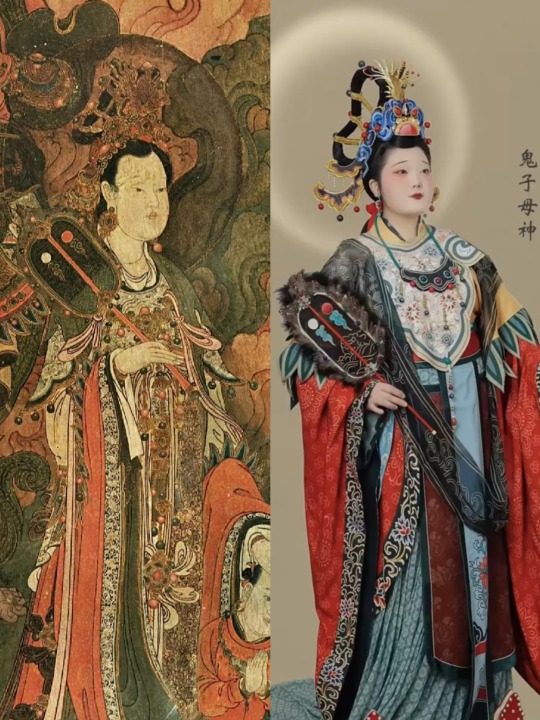
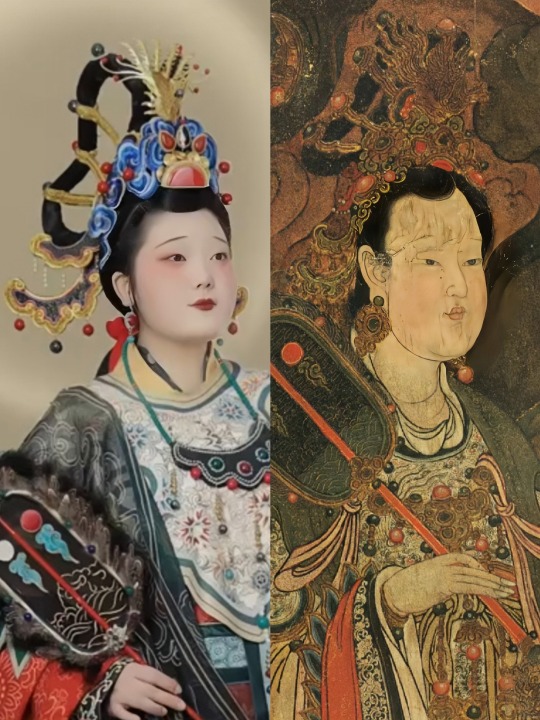





【Historical Artifacts Reference 】:
Ming Dynasty "鬼子母神" in the mural of Fahai Temple in Beijing,China.


【About the "鬼子母神" 】
鬼子母神,also known as Hārītī (Sanskrit),is both a revered goddess and demon, depending on the Buddhist tradition. She is one of the Twenty-Four Protective Deities of Mahayana Buddhism.
In her positive aspects, she is regarded for the protection of children, easy delivery and happy child rearing, while her negative aspects include the belief of her terror towards irresponsible parents and unruly children.
In both Chinese and Japanese Buddhism, she is venerated as a protector deity, but in many folk traditions is often recognized as a female demon of misery and unhappiness towards children and parents.
In Chinese Buddhism, Hārītī is also known as Hēlìdì (訶利帝) or Hēlìdìmǔ (訶梨帝母). In Chinese tradition, she is one of the Twenty-Four Protective Devas (二十四諸天 Èrshísì zhūtiān), a group of Dharmapalas who are venerated as protectors of Buddhists and the Dharma.Statues of this group (and Hārītī) are often enshrined within the Mahavira Hall in Chinese temples and monasteries.
————————
📸Recreation Work:@粉墨长安古典妆造
🔗 Xiaohongshu:http://xhslink.com/cNP1Hz
————————
#chinese hanfu#immortal Hanfu#hanfu#hanfu accessories#hanfu_challenge#china#chinese traditional clothing#chinese#Buddhist#buddhist art#鬼子母神#Fahai Temple Murals#chinese art#ancient china#漢服#汉服#中華風#Ming Dynasty
423 notes
·
View notes
Text








Laughing Buddhas From The Flying Peak
Vivid figures of Buddhas and Bodhisattvas carved in the rock on the Flying Peak, Feilai Feng (飛來峰石窟) in the Wulin Mountains (武林山), Zhejiang.
Their cheerfulness in no way contradicts the solemn and misty ambiance of the Feilai Feng Grottoes themselves. Limestone peak looks alien in the surrounding mountain landscape, so there is an opinion that it flew here by the power of Buddhist wonder-workers. The main cave is dedicated to the Bodhisattva Guanyin. Due to a natural crack in the ceiling, a radiant halo surrounds the statue.
The carvings are from different periods and date from the Tang to the Ming.
Photo: ©俊灵-
#ancient china#chinese culture#chinese art#buddha#buddhist#buddhist deities#buddhism#buddhist temple#guanyin#chinese mythology#观音#religious art#rock carvings#buddha statue#bodhisattva#chinese folk religion#tang dynasty#song dynasty#yuan dynasty#ming dynasty
301 notes
·
View notes
Text
Me, staring at the "Nezha is eternally 12/Nezha is often depicted as a kid so he's just a kid and nothing else" crowd: man, have you heard of Child Manjushri a.k.a. Wenshu Tongzi
(This is totally not an excuse for me to find cool statue pictures and talk iconography)
So, here is Bodhisattva Manjushri in his standard "graceful aristocratic prince" form, riding his azure lion. The statue in the picture doesn't have it, but oftentimes, he'll also be holding a flaming sword that symbolizes wisdom's ability to cut through ignorance and delusions.
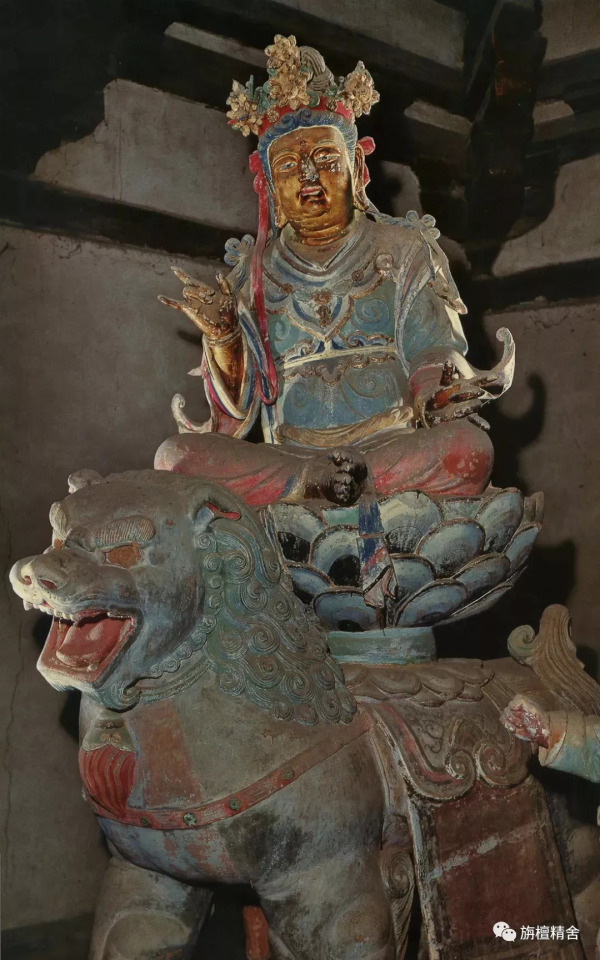
This is "Holy Old Monk Manjushri", a variant that I came across a few times while temple-touring, but couldn't find many good online pictures of. It seemed like a thing that was popular around Mt. Wutai, based on the "Buddha-palita met Old Man Manjushri" tale. Sometimes his BFF Samantabhadra is depicted as an old man too, for matching purposes.
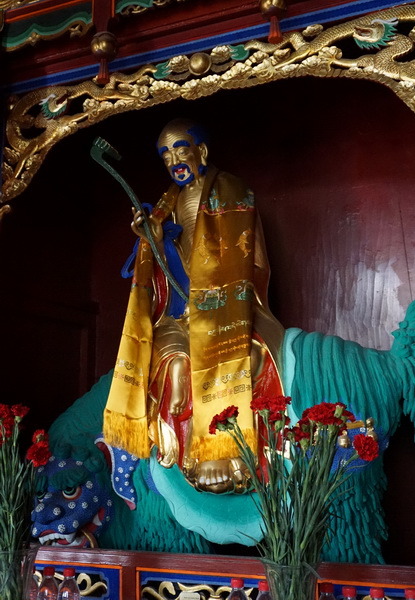
And this is Child Manjushri, with his five hair buns, often worshipped in an esoteric context. On Mt. Wutai, there are five major temples atop five peaks, each worshipping a different form of Manjushri, and the "middle peak" temple has a Child Manjushri in their main hall. Like, it's far from the most common variant, but neither is it this super obscure form that no longer enjoys active worship.
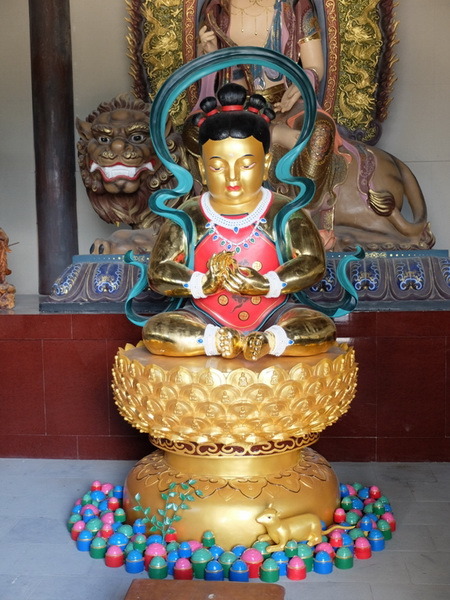
Lastly, just for fun: this is Yamantaka, a guardian deity/Wisdom King, who, in Tibetan Buddhism, is believed to be Manjushri's wrathful form.
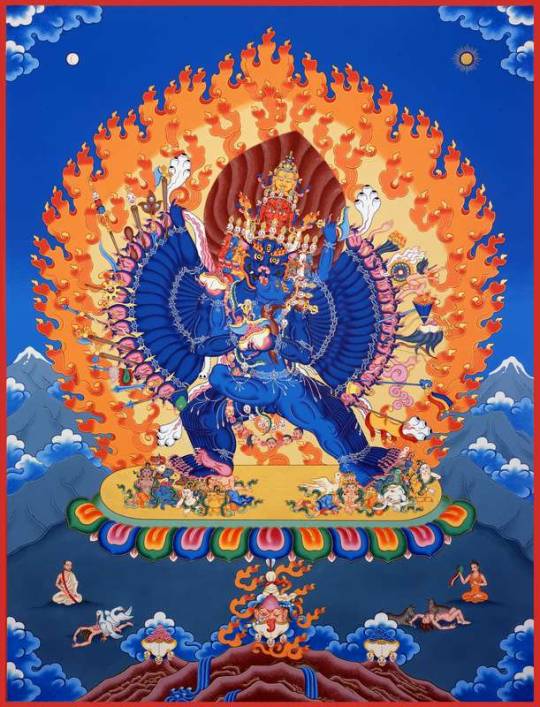
If you wouldn't call Manjushri "the eternal child Bodhisattva" just because he has a child form, why would you say Nezha is an eternal child when he, too, has both child and adult forms?
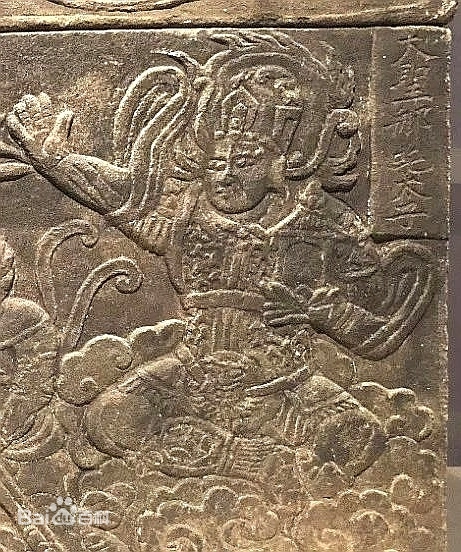
Even though Nezha's child form is vastly more popular and well-known than Child Manjushri, I think my point still stands: A deity is capable of having multiple manifestations, of varying ages and appearances, each fulfilling a particular function and niche——none of which is the "One True Form TM", just different clothes they wear based on occasions and audiences.
To stretch the analogy a little, Manjushri's child form is the formal dress he puts on before attending a religious event, while Nezha's child form is the lotus T-shirt he wears a lot while appearing on TV, to the point it becomes his most iconic attire.
This doesn't mean he only has a single shirt, for goodness sake, and using his child form as evidence for the "eternal child" claim is like saying Nezha's only allowed to wear that one shirt and nothing else.
#chinese mythology#chinese religion#buddhism#manjushri#bodhisattva#nezha#buddhist art#fandom discourse#lego monkie kid#...tagging lmk because where else would I see the “eternally 12” thing proliferate#this will be my only two cents on the topic#barring answering asks that are specifically about Nezha in FSYY/JTTW
156 notes
·
View notes
Text
My bodhisattva: "My dear sweet girl you must remember to breathe out the chaos and breathe in the calmness."
Me:

#shitpost#religious humor#buddhist witch#chinese buddhist#guanyin#bodhisattva#buddhism#religions#spirituality
51 notes
·
View notes
Photo

Kami
In the Shinto religion kami is an all-embracing term which signifies gods, spirits, deified mortals, ancestors, natural phenomena, and supernatural powers. All of these kami can influence people's everyday lives and so they are worshipped, given offerings, solicited for aid and, in some cases, appealed to for their skills in divination. Kami are attracted by purity - both physical and spiritual - and repelled by the lack of it, including disharmony. Kami are particularly associated with nature and may be present at sites such as mountains, waterfalls, trees, and unusually shaped rocks. For this reason, there are said to be 8 million kami, a number referred to as yaoyorozu-no-kamigami. Many kami are known nationally, but a great many more belong only to small rural communities, and each family has its own ancestral kami.
The reverence for spirits thought to reside in places of great natural beauty, meteorological phenomena, and certain animals goes back to at least the 1st millennium BCE in ancient Japan. Add to these the group of Shinto gods, heroes, and family ancestors, as wells as bodhisattvas assimilated from Buddhism, and one has an almost limitless number of kami. Common to all kami are their four mitama (spirits or natures) one of which may predominate depending on circumstances: aramitama (wild or rough), nigimitama (gentle, life-supporting), kushimatama (wonderous), and sakimitama (nurturing). This division emphasises that kami can be capable of both good and bad. Despite their great number, kami can be classified into various categories. There are different approaches to categorization, some scholars use the function of the kami, others their nature (water, fire, field, etc.). For simplicity, and as those methods mentioned tend to create a lot of overlap, we will here adopt historian M. Ashkenazi's approach.
Classical Kami
Here the 'classical' kami are those which appear in the oldest Shinto texts including the Kojiki and Nihon Shoki. Here we have the gods, supreme amongst them being Amaterasu, the sun goddess. Others include her brother Susanoo, the wind and sea god, Takamimusubi, Okuninushi, and the creator gods Izanami and Izanagi. The first gods who remained in the heavens are often referred to as amatsukami (heavenly kami) while those next generation gods who ruled first on earth are called kunitsukami (earthly kami). All of the kami occasionally, in times of great crisis, assemble for conference on the dry riverbed of the Heavenly River. Many important rivers, mountains, caves, and rocks have their own kami too. In this group are also two kami from across the sea: Sukunabikona and Sarutahiko.
Continue reading...
41 notes
·
View notes
Text








Shuanglin Temple 双林寺 is a 6th century Buddhist temple in Shanxi province, China.
It’s a UNESCO World Heritage site, and is protected by the state administration.
The temple was featured in the 2024 game “Black Myth: Wukong”
#china#chinese architecture#chinese#🇨🇳#northern China#chinese heritage#han chinese#Buddhism#temples#chinese buddhism#Buddhist temple#chinese temple#Buddha#sun wukong#black myth wukong#Shanxi#northern qi dynasty#northern qi#journey to the West#jttw#east asia
203 notes
·
View notes
Text

Irene Chou (Zhou Lüyun, 1924-2011) — Experience in Meditation [ink and color on xuan paper, hanging scroll, 1978]
666 notes
·
View notes
Text

Longmen (Dragon’s Gate) Grottoes, Henan, China
Carved from 493 to 1127 CE, they contain over 100.000 statues within 2.345 caves, nearly 2500 stelae and inscriptions, and over 60 Buddhist pagodas.
51 notes
·
View notes
Text
Oh no ...
Someone aware of my recently-finished catalog of Sun Wukong's powers and skills indirectly requested that I make a list of powers from Fengshen yanyi (封���演義, c. 1620).
But I don't have the mental energy for it. Plus, I am not as familiar with the book as I am JTTW. I'll pass the torch onto someone else ... COUGH @ryin-silverfish COUGH.

#journey to the west#jttw#fengshen yanyi#fsyy#list of powers#magic powers#twitter#sun wukong#monkey king#magic#chinese magic#taoist magic#daoist magic#buddhist magic#pass the torch
68 notes
·
View notes